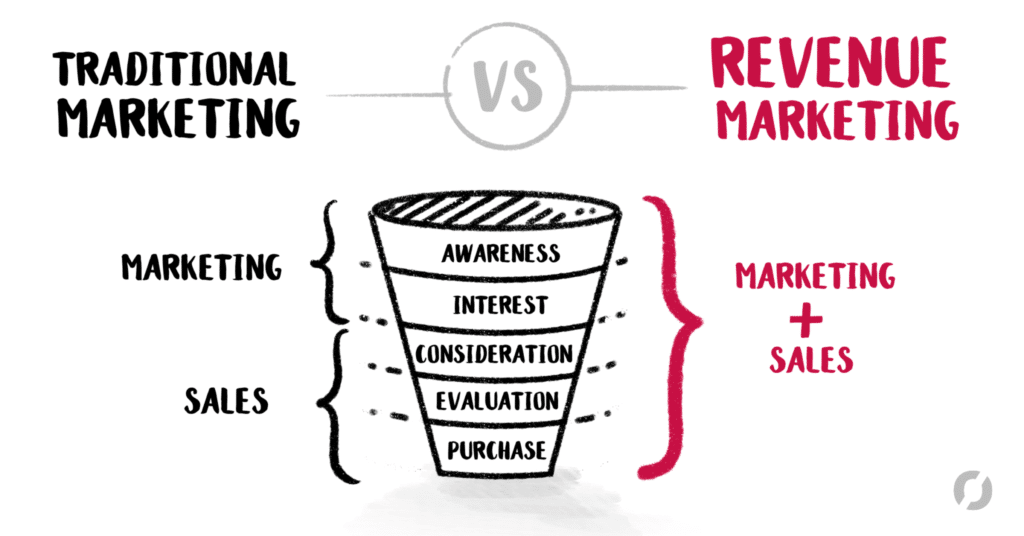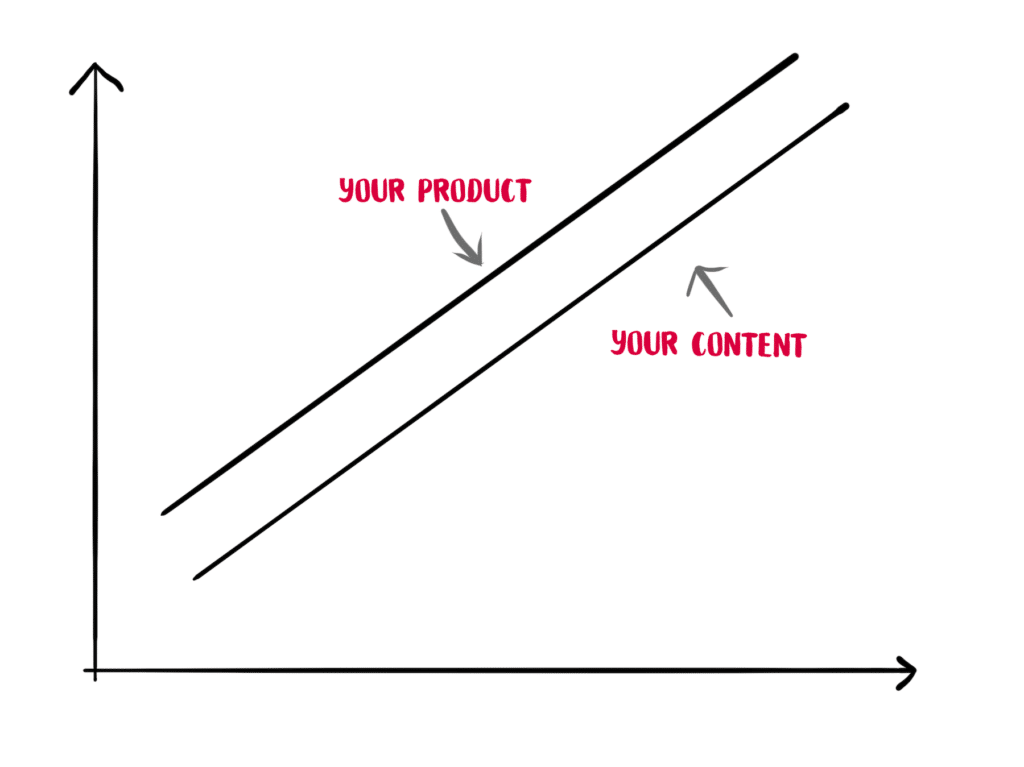Revenue Marketing – The best bet marketers can make in 2023

Chances are you’ve never heard the term Revenue Marketing. Yet, it’s likely one of the most interesting trends in the marketing space right now. One that could forever change traditional marketing, from the top of the funnel down to the very bottom.
I’ve actually been thinking about revenue marketing before I knew it existed as a term. If you look at what we’ve been doing at Breadcrumbs with our revenue acceleration manifesto… you’ll notice it’s actually quite close to the revenue marketing process.
Is Revenue Marketing something you should care about?
Long story short: Yes, as long as you want to grow your revenue more efficiently and transform your marketing team from a cost center into a revenue center.
A quick search on Linkedin shows a steep rise in the number of roles related to revenue marketing. Companies of all sizes and across every industry are starting the revenue marketing journey. As of today, there are already 3.8 million revenue marketers across the globe in top-tier companies. And this is not even counting related titles like CRO.

If you know me, you’ll know in the past I’ve been on the fence for many of the new marketing-related job titles popping out like mushrooms: Inbound Marketer, Content Marketer, Growth Hacker, and so on.
Very often, these were just slight adjustments to what already existed to adapt to the latest buzzwords. Revenue Marketing is way more transformational both in terms of how we structure sales and marketing teams and how they’re run.
What is Revenue Marketing?
Revenue Marketing is a holistic approach that breaks down the sales and marketing silos, aligning the two organizations toward increasing revenue and ROI.

If your organization is like most businesses, you have likely already experienced the tension between the marketing and sales team.
The marketing team is often measured on its lead generation or demand generation effort. This often results in optimizing for quantity over quality.
The sales team doesn’t care about leads. They care about the actual pipeline because they’re measured on new revenue generated. They couldn’t care less about those thousands of users that signed up for the newsletter or downloaded the latest ebook if they’re not ready to enter the sales pipeline.
What’s wrong with traditional marketing?
If you think about it quite crazy. Everyone says how hard it was to measure marketing effectiveness before the Internet arrived. Nowadays, we measure everything. Often you’ll hear complaints about the overflow of data points rather than the lack thereof.
Yet, in 2023, most businesses still measure their marketing strategy’s effectiveness based on increased traffic and lead rather than pipeline and revenue.
Most content marketing teams can talk for hours about the increase in SEO traffic. They know what keywords they’re ranking for, and they know how many likes and shares the last post generated. Sometimes they also know how many leads that blog post generated. But revenue?
They have no clue if a successful piece of content that generates a huge amount of traffic has any impact on sales.
The Content Marketing Dilemma
I’ve seen this first hand across any kind of company. The SEO team comes up with a great keyword that is somewhere related to your industry. The content team produces pillar content, 6,000+ words long that ranks n.1 and generates a huge amount of traffic. Sometimes it even becomes the n. 1 source of traffic for the website.
BUT… even tho’ that piece of content is somehow targeting the right buyer persona, it has no real connection with the product you’re trying to sell or with an intent to buy. It might be good for lead generation, but it never attracts real customers.
Garett Moon, in his great book, “10x Marketing Formula”, defines this kind of blog post as parallel content. It’s content that targets the right audience but never intersects with your product. This book made it in my Best Marketing Books roundup by the way.

I’ve experienced it firsthand in AdEspresso. We had many very popular blog posts like “Buy Facebook Likes, and you’ll damage your brand” or “50 Call To Action Examples“.
These articles, over time, generated a huge amount of traffic. But people looking for those topics, even tho’ they were marketing, were not looking for a Facebook Ads tool. Had we put them offline, we would have lost a lot of traffic, but nothing would have changed from a demand generation or sales standpoint.
It was a marketing effort that was generating vanity metrics but had no real impact on revenue. Those visitors were not sales-ready!
The Revenue Marketing benefits
Transitioning from traditional marketing to revenue marketing will dramatically accelerate your revenue and optimize the sales and marketing teams’ effectiveness.
Every change you’ll make to your company organization to move towards revenue marketing will result in immediate benefits, both for you and for your customers:
- You’ll be able to measure the impact on the revenue of each marketing campaign.
- Sales and Marketing teams will be more aligned and will work together closely instead of complaining about each other.
- You’ll really become a customer-centric organization. Customers don’t care about how you’re structured; they care about your product and services’ quality. Breaking down silos will help you serve them better.
- The CEO will have a better understanding of the impact of marketing on the company’s revenue.
- The marketing budget will have a higher ROI because it will be spent only on campaigns that generate real revenue. This will unlock an extra budget for the team to scale operations.
- Marketing automation will work more smoothly and with better data, giving you back more time to focus on more important activities.
- Leads generated will be more qualified for the sales team to close them quickly.
- Marketers in your company will be happier because they’ll understand their impact on the business. Their compensation will finally include a variable part based on performance.
As you can understand, revenue marketing is disruptive, especially for b2b companies, and it’s something more and more businesses will soon embrace. It’s up to you if you want to be ahead of the curve or late in the game.
It’s also worth mentioning that not all businesses will get the same level of benefit from implementing revenue marketing. In my opinion, these businesses will benefit more from it:
- SaaS companies selling to mid/large companies with a sales motion. This is the sweet spot!
- Self-service only online businesses
- b2c and eCommerce
Of course, implementing this new approach is not as simple as a quick change in marketing strategy. I can’t stress this enough, don’t expect the CMO or the CRO to implement this in a snap of the fingers. Before you can see results, you’ll need the whole company to be focused on building the right process, identifying the right metrics and goals to track, the right technology to use, and more.
It’s a journey.
The Revenue Marketing Journey
The first step for marketers willing to take on this journey is to assess at what maturity stage their business is right now.
In The Revenue Marketing Book, the author describes four Revenue marketing maturity stages:
- Traditional: Marketing is used for party planning, focused only on brand awareness and not even generating leads. It’s accounted for expenses and campaigns.
- Lead Generation: Marketers focus on acquiring emails for lead gen, the main goal is to optimize cost per lead, and that’s what they’re accounted for.
- Demand Generation: More marketing automation and focus on MQL and SQL. Still a lot of disagreements with sales on lead quality. Accounted for costs and revenue pipeline.
- Revenue Marketing: Martech to map the entire customer journey. Focus on building revenue predictability and a repeatable process—good alignment with Sales, Customer Support, and Customer Success. Marketers are accountable for revenue generated, ROI, and revenue forecast.
Most of the companies I’ve helped are usually in stage 2 or 3. Very few have reached stage 4. The ones in stage 1 are usually not in the digital world… which sounds crazy today!
Once you’ve made an honest analysis of where your business is, it’s time to start building your engine.
Building a Revenue Marketing Engine
As I’ve said before, you’re setting yourself up for a big transformation. It’s not gonna be quick nor easy, so brace yourself.
In my opinion, these are the key steps you’ll have to make to unlock the full potential of revenue marketing:
1. Get strong C-Level commitment
Of course, every executive would love to see the marketing team more efficient and accountable for revenue growth.
Yet be sure there will be some pushback.
Often this is not gonna be because the CMO doesn’t want to be accountable, but more likely for fear of change or of the temporary dip in profitability that can happen every time, there’s a big metamorphosis.
Management could likely also be impacted by the reorganization. KPIs will change for each role; more collaboration will be needed, and who reports to whom will likely change.
It’s critical to get everyone fully committed, starting from the CEO. I’ve seen this transformation derail too often because the CEO was playing favorites either with marketing or sales.
2. Keep customers in the loop
In the process, expect some disruption for customers too. You’ll be reviewing and making changes across all your funnel.
The good news is that usually, they are way more forgiving than you can imagine when you’re transparent with them.
Keep the communication channel open and let them know ahead of time how things will change in how you engage with them and clearly explain the benefits for everyone involved.
3. Drive Alignment
Getting everyone in the organization to understand what revenue marketing is, is the easy part.
Building the processes to get everyone really aligned is the real challenge, especially when it comes to an age-old feud like the one between marketing and sales.
Yet silos cannot exist anymore. Get marketers and salespeople in the same room and have them agree on how to get together to the revenue goal.
Key elements to align on will be:
- Definition of a sales-ready lead
- Key elements to qualify leads
- Customer personas to go after
- Accounts the salespeople are interested in
- Marketing material needed by sales to close deals
Once you’ve aligned sales and marketing, move to the rest of the business. It’s very important that product, customer support, and customer success all have a clear understanding of how they should collaborate to reach revenue goals.
4. Get the right people in the right places
Very often, as you go through this journey, you’ll realize you don’t have the right people in your company to implement revenue marketing. Or you might have the right people but in the wrong places.
Start with the C-level. Do they have the right skills to lead this transformation?
There’s no one size fits all recommendation here; it really depends on your business setup.
The most common problems I’ve seen at the C-level:
- Old school CMO who’s not enough data-driven
- Sales and marketing reporting to different leaders
- Lack of a CRO
Once you have the right leadership check the rest of the organization for gaps.
The most common one is the lack of dedicated data analysts in the marketing org who can support marketers in analyzing data.
5. Review your MarTech stack
If you’re like most companies I’ve worked with, your MarTech stack is already overcrowded with any kind of software you can dream of.
Technology is the core of Revenue Marketing. Without the proper tools you’ll fail, and you’ll waste a lot of money too: An average mid-sized company can spend 20 to 25% of its marketing budget on technology.
You’ll have a lot of work to do here. There are two main directions you can take:
- An All-In-One tool that can centralize as much as possible your data like Hubspot
- A set of best in class tools for each category tightly integrated through APIs
Both options have pros and cons. The first one is easier but you might not be using the best solution for every task. The second one will require much more development work on your side to implement and maintain.
Here’s a list of tools you’ll need in your MarTech stack:
- CRM (Salesforce, Hubspot, AutopilotHQ…)
- Marketing Automation (Hubspot, ActiveCampaign, Drift…)
- Attribution (Funnel.io…)
- BI/Reporting (Google Data Studio, Wicked Reports…)
- Data Connector (Supermetrics)
- Data Enrichment (People Data Lab, Clearbit…)
A critical element will be determining what your source of truth is and be sure to sync there all the information you have from other tools so users can quickly have a unified view from a single place.
Tools like Segment can help a lot in managing and syncing all your data and building an internal data warehouse.
Having the right tools and collecting the right data is critical for revenue marketing. It’s gonna be the enabler to really see what marketing activities have helped move visitors to the bottom of the funnel and what activities are not impacting your pipeline and revenue and should be discontinued.
6. The Revenue Attribution Nightmare
Attribution will be for sure your biggest pain point in this journey.
There’s really no right or wrong formula to attribute revenue to the various touchpoints that a user goes through before becoming a customer.
if you heavily rely on paid acquisition things could be a bit easier. A simple last-click attribution could give good enough results.
But if you’re betting heavily on content and inbound to attract visitors, the sales cycle usually becomes longer. A user could discover you for an interesting blog post, become a lead after a month, and interact with your emails multiple times before requesting a demo or signing up for a free trial. In this case, a linear attribution model could make more sense.
Marketers will have to test multiple attribution models to see which one seems more spot-on and go for it. No model is gonna be perfect anyway.
Are you ready for Revenue Marketing?
There’s no doubt most digital marketers are excited by the concept of Revenue Marketing.
Not only it’s gonna help them show the value of what they’re doing for the company, but it’s also a great source of data to continuously improve what they are doing in a data-driven way.
It’s also a big challenge and be prepared to allocate a lot of time and effort before you have a well-oiled engine.
In my experience, b2b companies, especially those selling digital products, should start their journey to implement revenue marketing today.
It’s transformational and will focus your whole company on customer experience and growing revenues. You’ll be surprised by the amount of useful data you’ll unlock as you implement it. These data will improve your ROI in ways you can’t even imagine and will also help you drive your product strategy and improve collaboration across your teams.
I’ll try to write a follow-up post soon with more hands-on examples of how we’re implementing Revenue Marketing in Breadcrumbs. In the meanwhile, you can check out my guide to b2b marketing for SaaS.
In the meanwhile why don’t you take a minute to share your personal experience in the comments below?

